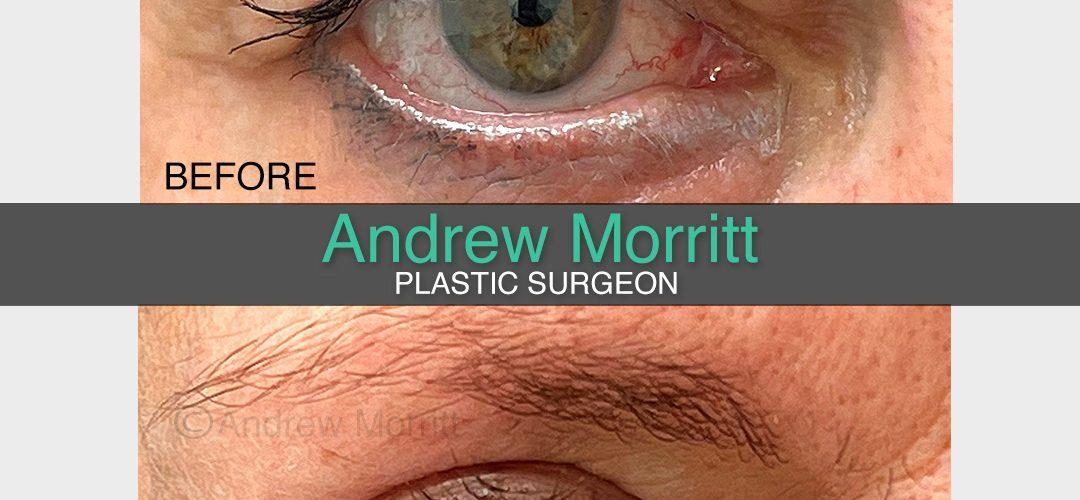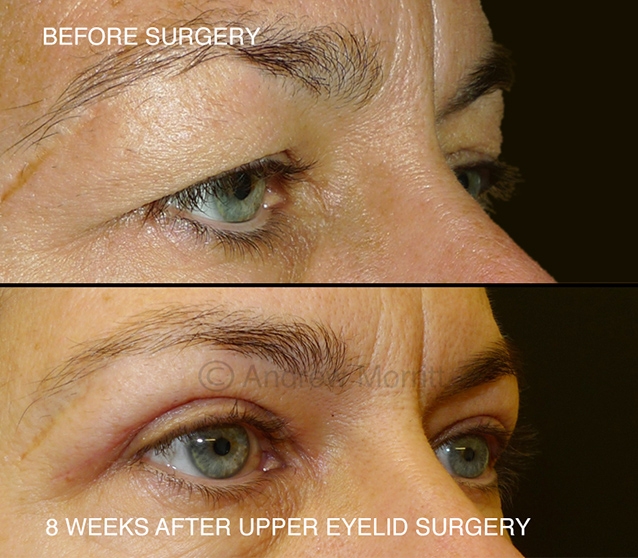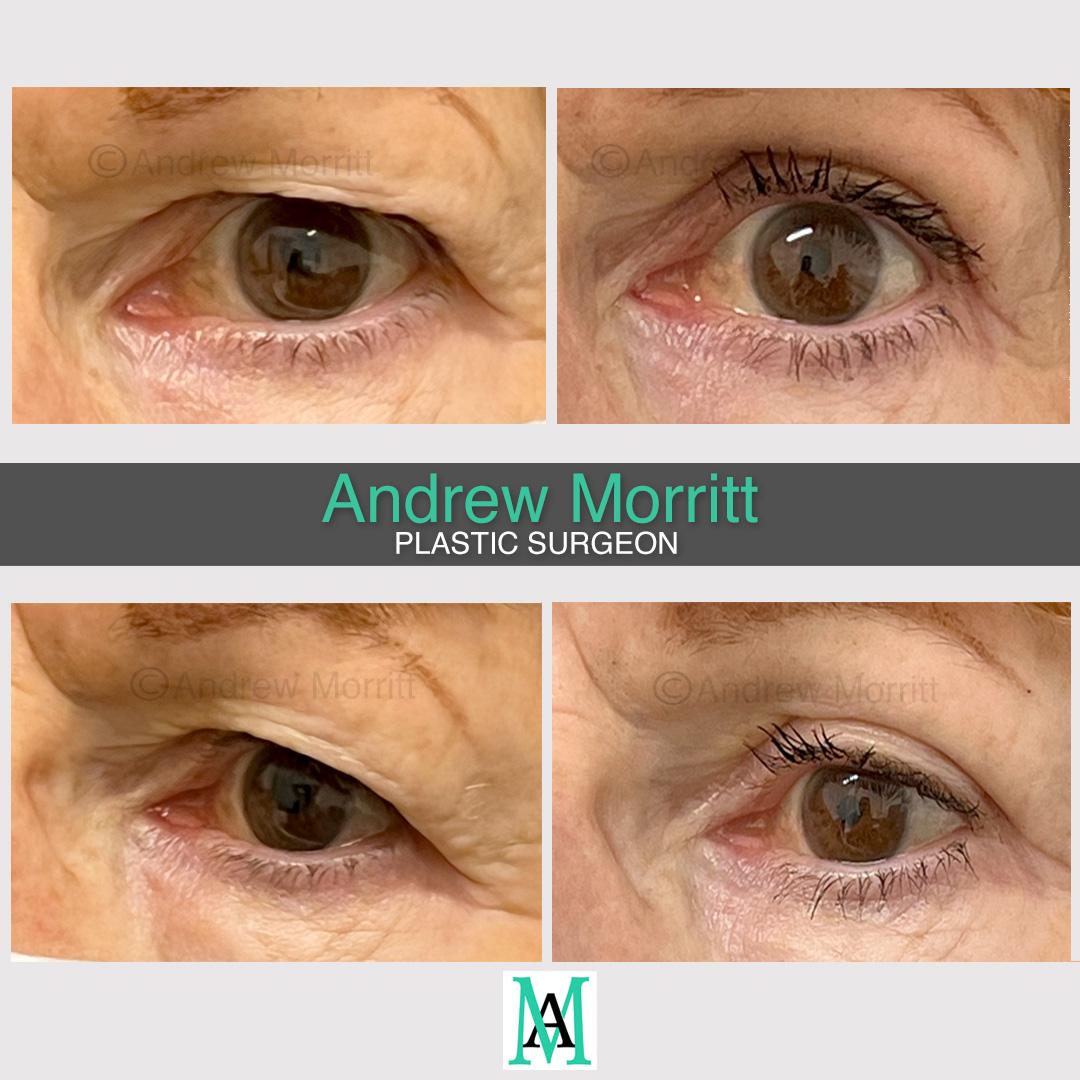Mr Morritt regularly performs blepharoplasty surgery at the Spire Claremont, and the Thornbury private hospitals in Sheffield. Upper eyelid lift surgery (upper blepharoplasty) is most frequently performed to remove excess skin from the upper eyelid. Sometimes patients have bulging caused by collections of fat around the eyeball and these can also be reduced in size. Lower eyelid surgery is most frequently requested to improve the appearance of ‘eye bags’. Mr Morritt frequently undertakes cosmetic eyelid procedures and reconstructive eyelid surgery and aims to deliver natural looking results.
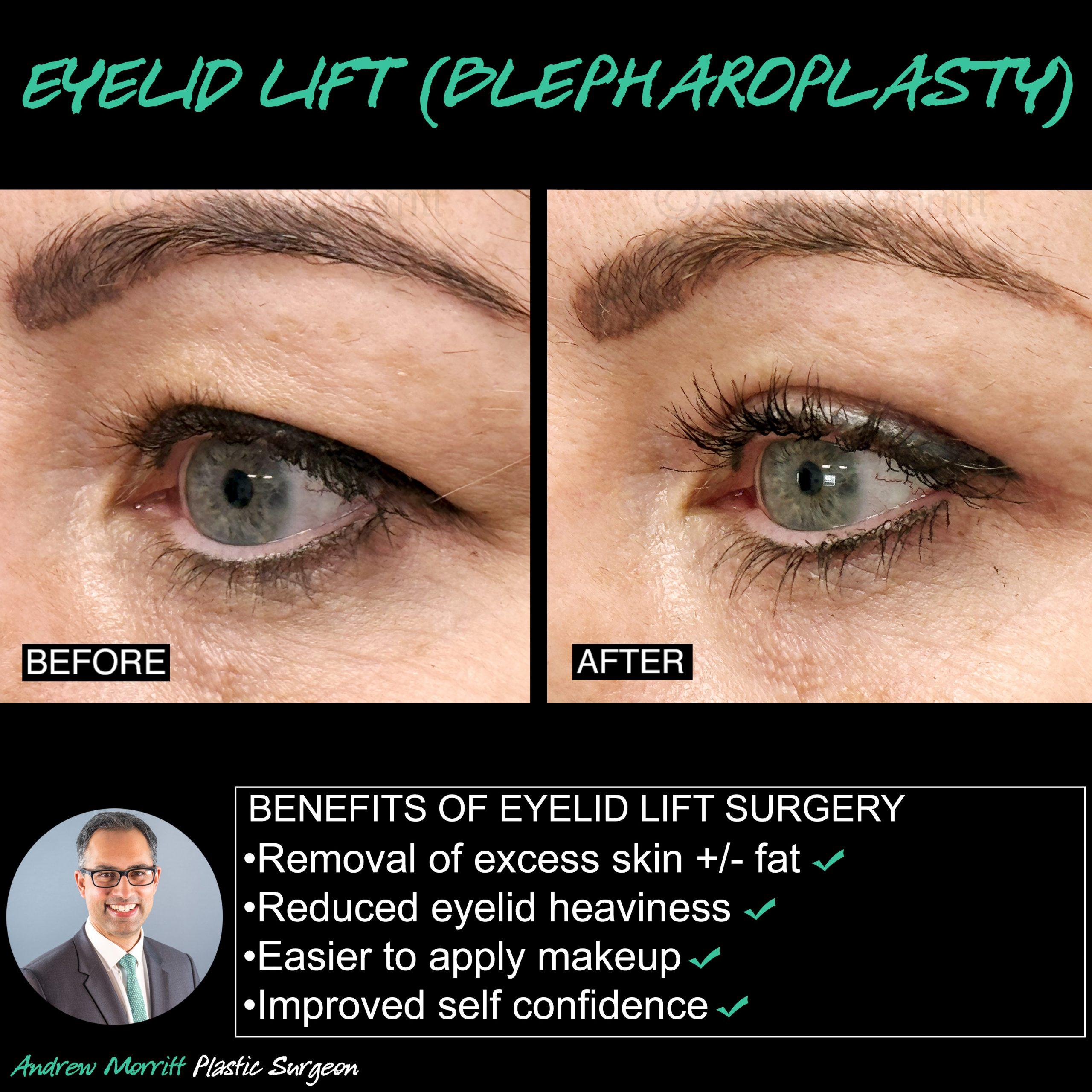
Who requests upper blepharoplasty (eyelid lift surgery)?
Patients requesting upper blepharoplasty surgery are generally concerned about excess skin on the upper eyelids. The amounts of excess skin can vary from those patients who have small amounts to those where there is so much excess skin that it rests on the eyelids and may obscure the vision. Some patients are concerned about bulging in the upper eyelid which is usually due to deposits of fat. Patients will often report that their loose eyelid skin makes it difficult to apply makeup or gives them a sensation of eyelid heaviness. Others are unhappy because they can’t see their eyelid crease clearly. Patients having upper blepharoplasty are most frequently in the age range 40-70 years. It is not uncommon for patients to mention that one parent had a similar problem with excess eyelid skin.
Upper blepharoplasty (eyelid lift) – procedure
Upper blepharoplasty is generally performed under local anaesthetic (patient is awake during surgery). For those who don’t like needles we offer the extra option of sedation (the patient is still awake during surgery but made to feel very calm and relaxed with a sedative). Upper blepharoplasty is sometimes performed under general anaesthetic for those who are particularly squeamish or if patient’s are having eyelid surgery at the same time as another procedure e.g. breast surgery or tummy tuck surgery.
Surgery is conducted in an operating theatre with the patient lying on their back. The local anaesthetic is injected under the upper eyelid skin with a fine needle. The local anaesthetic contains adrenaline which is used to reduce bleeding during surgery. Eyelid surgery commences once the skin is completely numb and involves removal of skin. In some patients a small amount of fat and/or eyelid muscle is removed if there is excess fat or muscle. Care is taken to ensure that all bleeding points are sealed (cautery). The skin is then closed with a fine stitch. Steristrips are used to hold the ends of the stitch in place. Ointment (chloramphenicol) is used on the central part of the incision as it is uncomfortable to have steristrips in this location. Cooling eye pads are then applied to reduce swelling.
Patients are observed in hospital for a few hours after surgery and go home the same day once they and the nursing team are happy. The stitches are removed by the nursing team 5-6 days after the procedure. Mr Morritt prefers to use stitches that are removed as he finds that this type of stitch gives the best cosmetic outcome and that self-dissolving sutures give less predictable results.
Video showing Mr Morritt’s upper blepharoplasty (eyelid lift) technique
Before/after photos upper blepharoplasty (eyelid lift) surgery
Case summary – for information on specific cases please see details below
Case 1: Before and after photos: Natural looking outcome for this lady in her 40s from skin only upper blepharoplasty giving improved eyelid definition and making it easier for the patient to apply eye shadow. Thanks to my patient for giving permission to show these images.
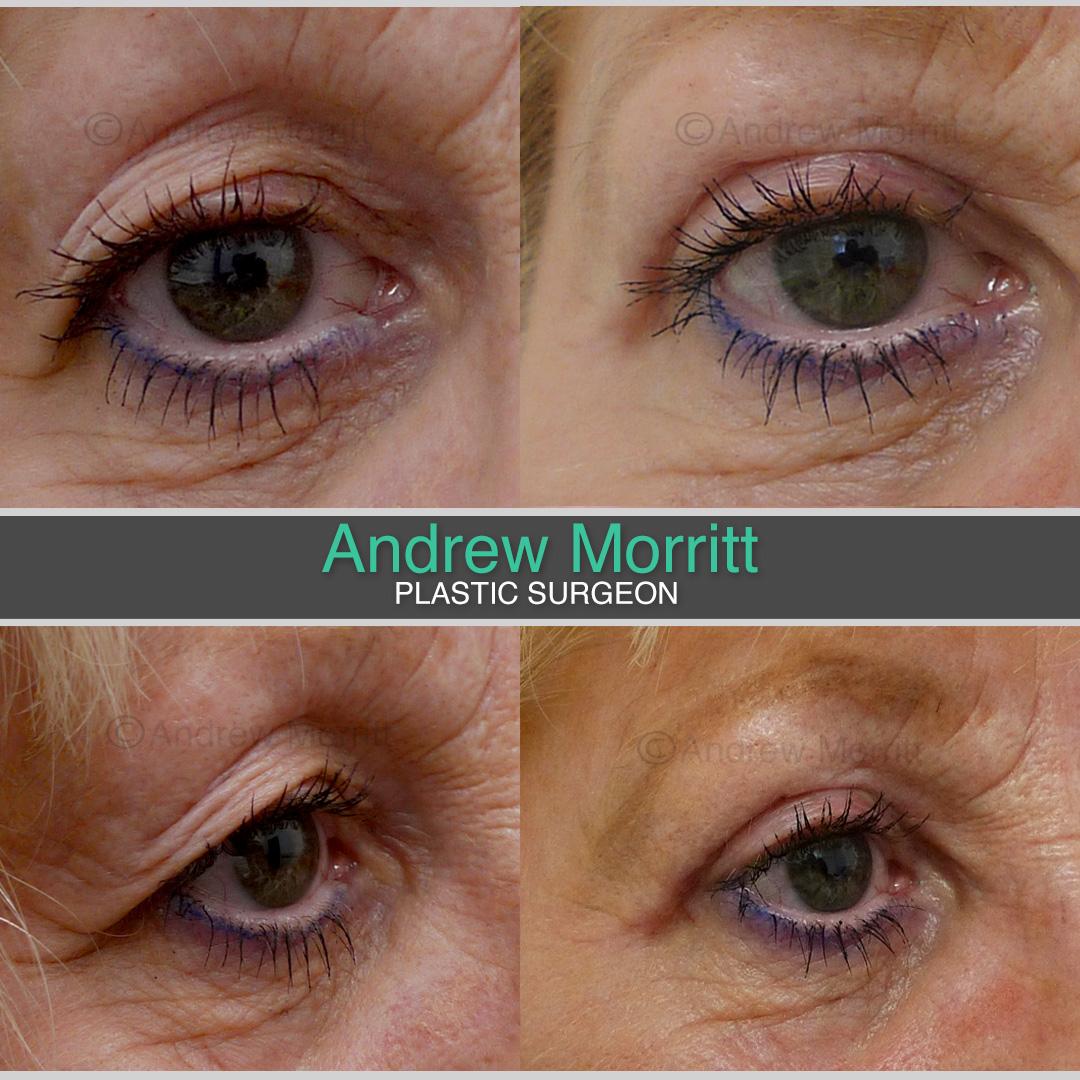
Case 2: Before and after photos: I removed a significant amount of excess skin from this lady’s upper eyelids (almost 2 cm of skin from each eyelid) giving a refreshed look and crisper definition to the eyelid crease. Appearances are shown 5 weeks after surgery – the scars are expected to become paler with time. Thanks to my patient for giving permission to show these images.
Case 3. Before and after photos: Thanks to my patient for giving permission to share this series of photos showing the healing process after upper blepharoplasty eyelid surgery. As you can see the swelling and bruising worsen for a few days after surgery before then resolving. At the one week stage (when the stitches have been taken out) much of the swelling has gone and the bruising is generally minimal.
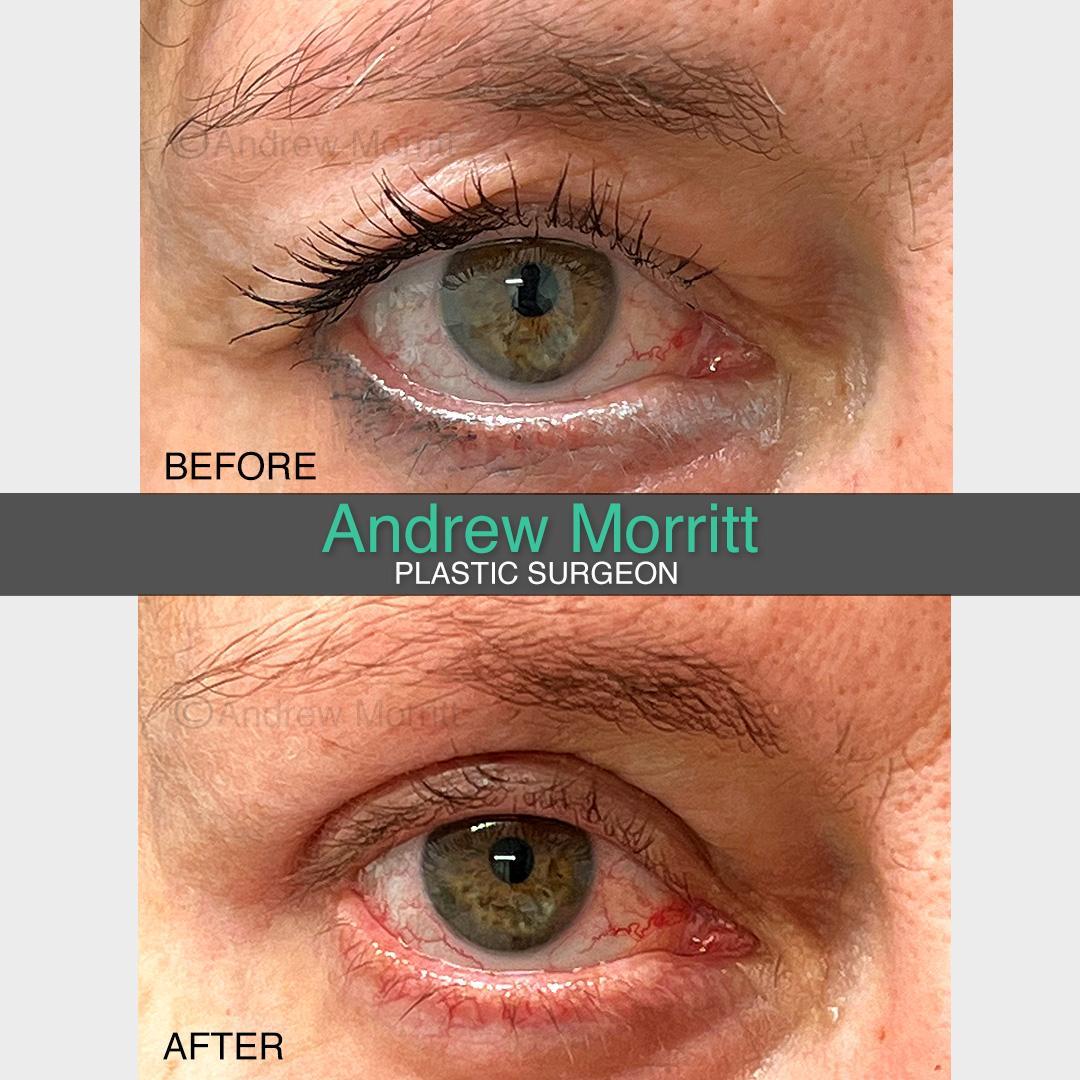
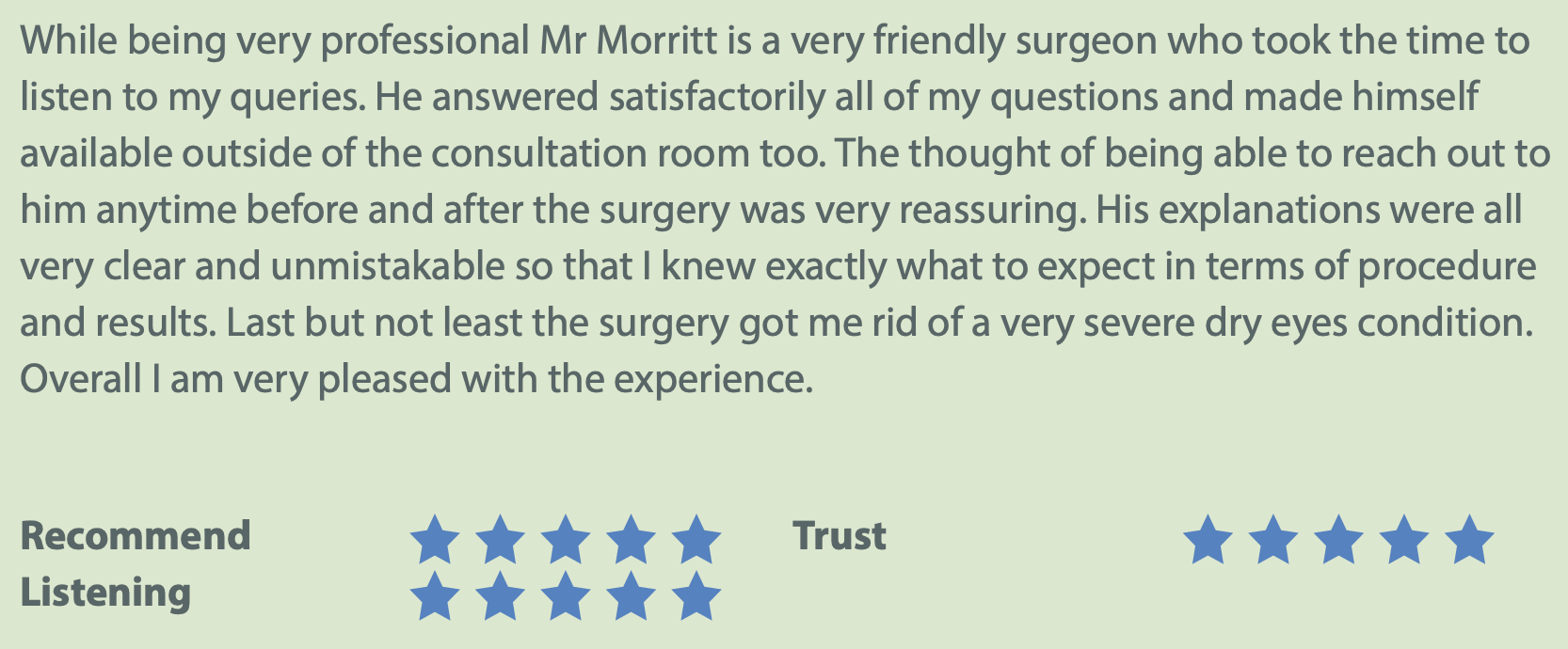
Case 4. Before and after photos: Photos showing the appearance before and 3 months after upper blepharoplasty surgery (eyelid lift). This lady in her 50’s had surgery because she was unhappy with the excess upper eyelid skin which felt heavy, made her look tired, and made it difficult for her to apply her eye makeup. The photo with the surgical markings shows how much skin was removed (2 cm in height). It was great to hear that the upper eyelid surgery improved the patient’s dry eye symptoms, in addition to improving her appearance. Thanks to my patient for giving permission to show these images.
Case 5. Photos showing appearance before and 7 weeks after upper eyelid skin excision (upper blepharoplasty). This lady in her 60’s was unhappy with the excess skin on the upper eyelid which made the eyelids feel heavy and prevented her from wearing eye makeup. Surgery performed under local anaesthetic (patient was awake during surgery but her eyelids were numb) has removed approximately 2cm of skin from each upper eyelid giving a more youthful look. Thanks to my patient for giving permission to show these images.
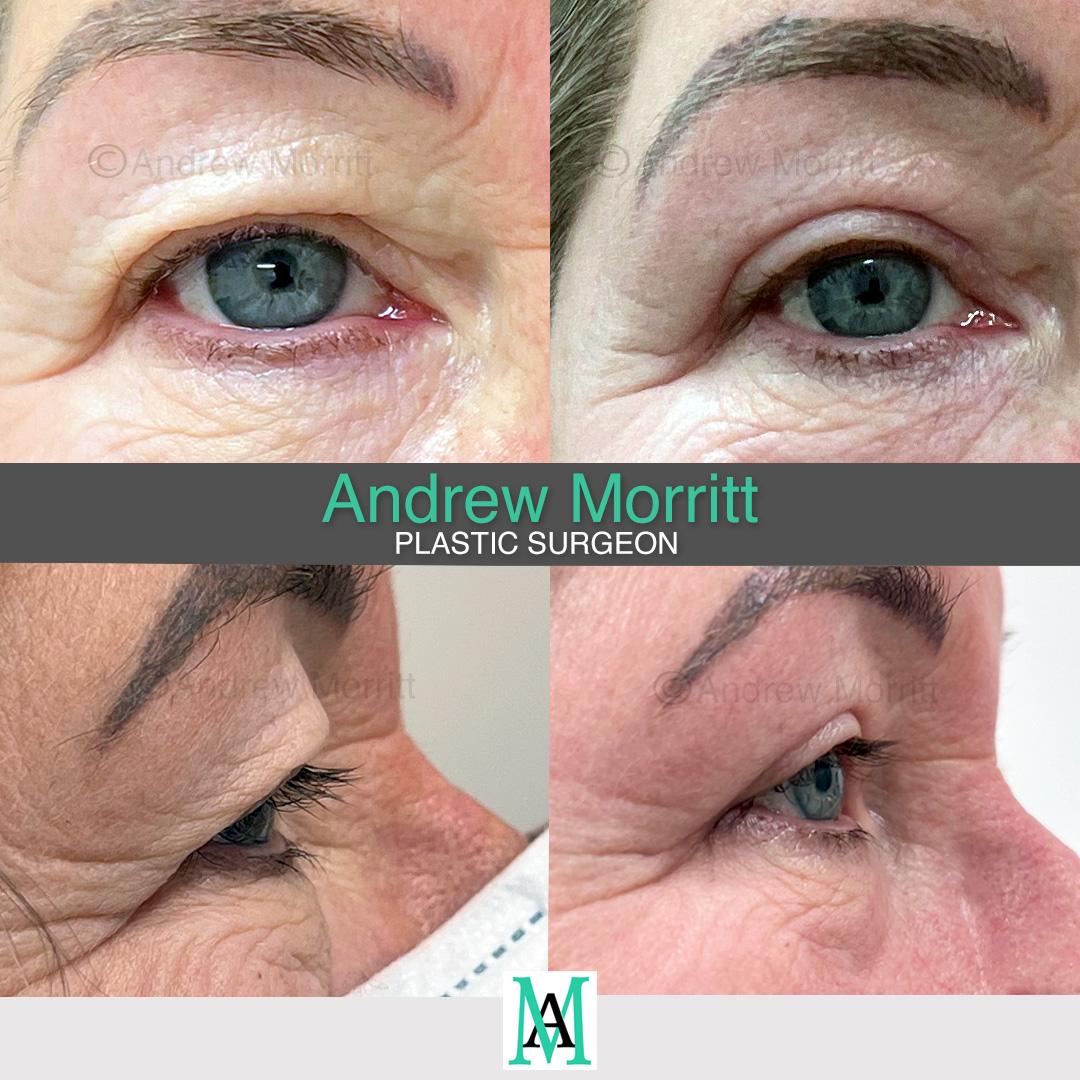
Case 6. Photos showing the appearances before and after upper eyelid skin removal (upper blepharoplasty) for this lady in her 50’s. This lady was unhappy with the excess upper eyelid skin which made it look like she didn’t have eyelids. Interestingly, this problem also affected her mum and aunt. 12mm of skin were removed here giving a more clearly defined upper eyelid crease and making it easier to apply makeup. Appearances shown 6 weeks after surgery.

Case 7. Before and after photos: Photos showing the appearances before and 7 weeks after upper eyelid skin removal (upper blepharoplasty) for this lady in her 50’s. The excess skin has been removed giving a refreshed look with better eyelid definition and making it easier to apply make-up. Thanks to my patient for giving permission to show these images.
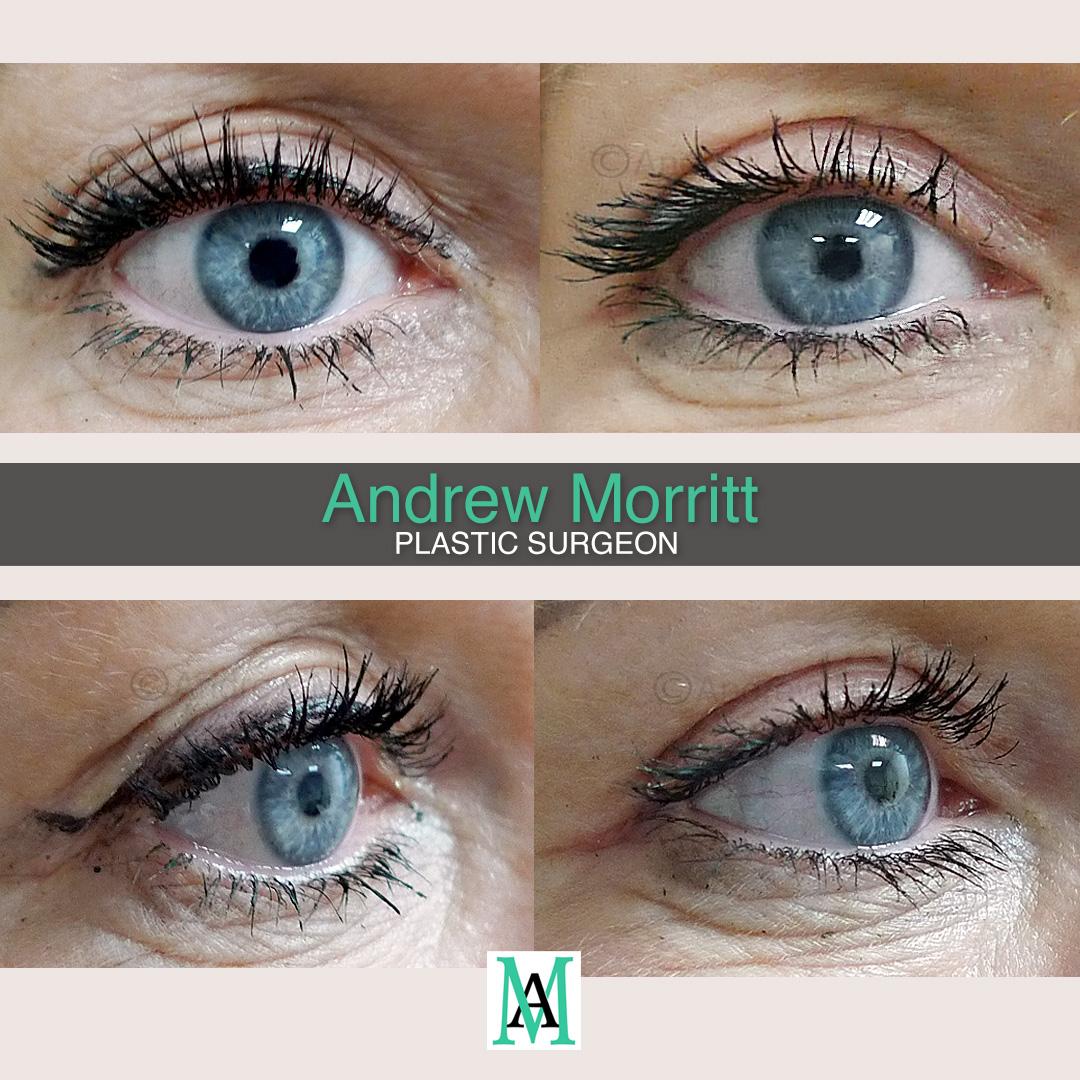
Case 8. Photos showing appearances before and after upper blepharoplasty. This lady in her 40s was unhappy with the excess skin which made it difficult to apply her makeup. Excess skin has been removed giving a refreshed look. Thanks to my patient for giving permission to show these images.

Case 9. Photos showing appearances before and after upper blepharoplasty eyelid surgery. This lady in her 40s was unhappy with the excess skin which made it difficult to apply her makeup. She also had asymmetry of her upper eyelid skin. Excess skin has been removed giving a sharper definition of the upper eyelid crease with a more youthful look. Thanks to my patient for giving permission to show these images.
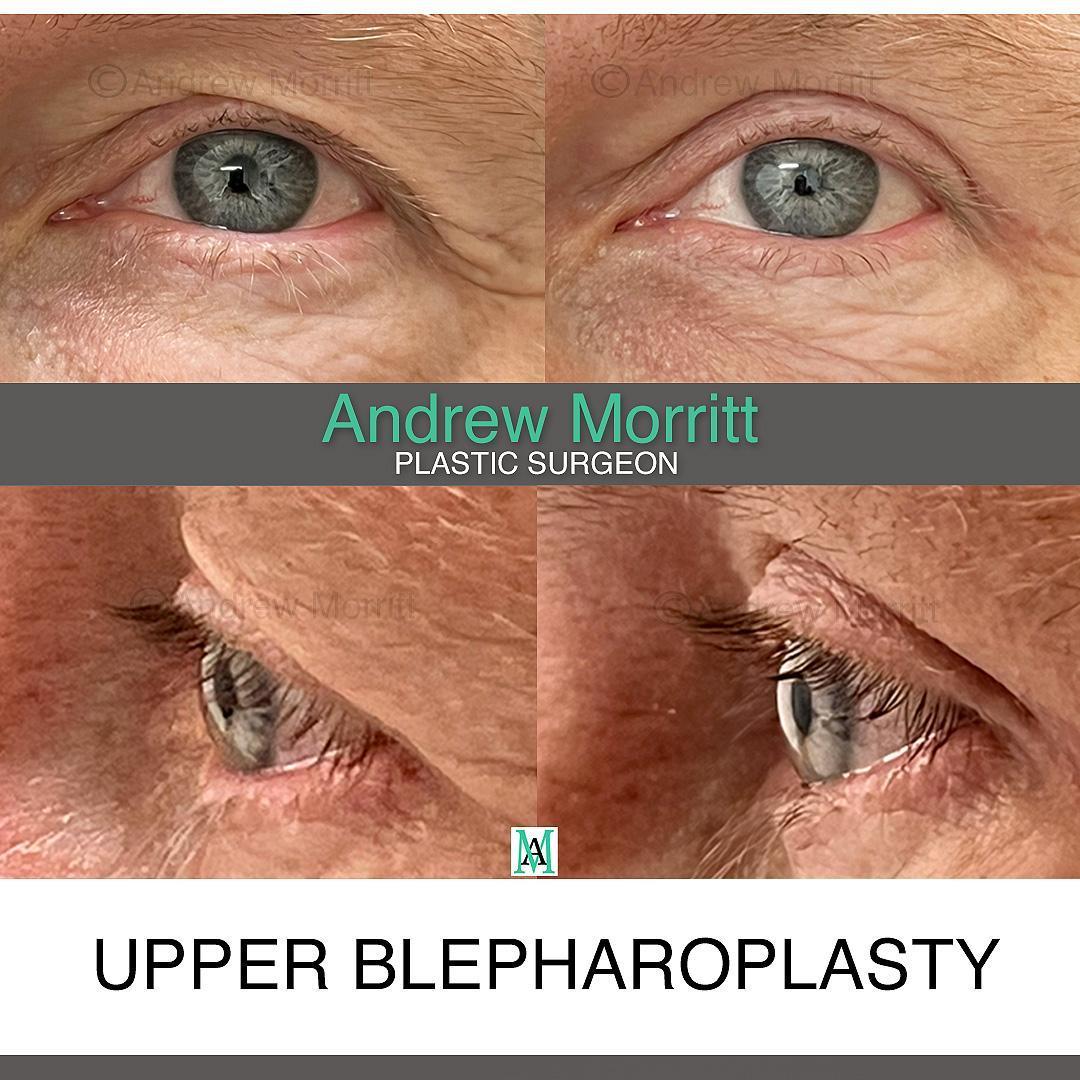
Case 10. Photos showing appearances before and 8 weeks after upper blepharoplasty eyelid surgery. This man in his 50’s was unhappy with the heaviness and wanted a refreshed look without the change being too obvious. Thanks to my patient for giving permission to show these images.
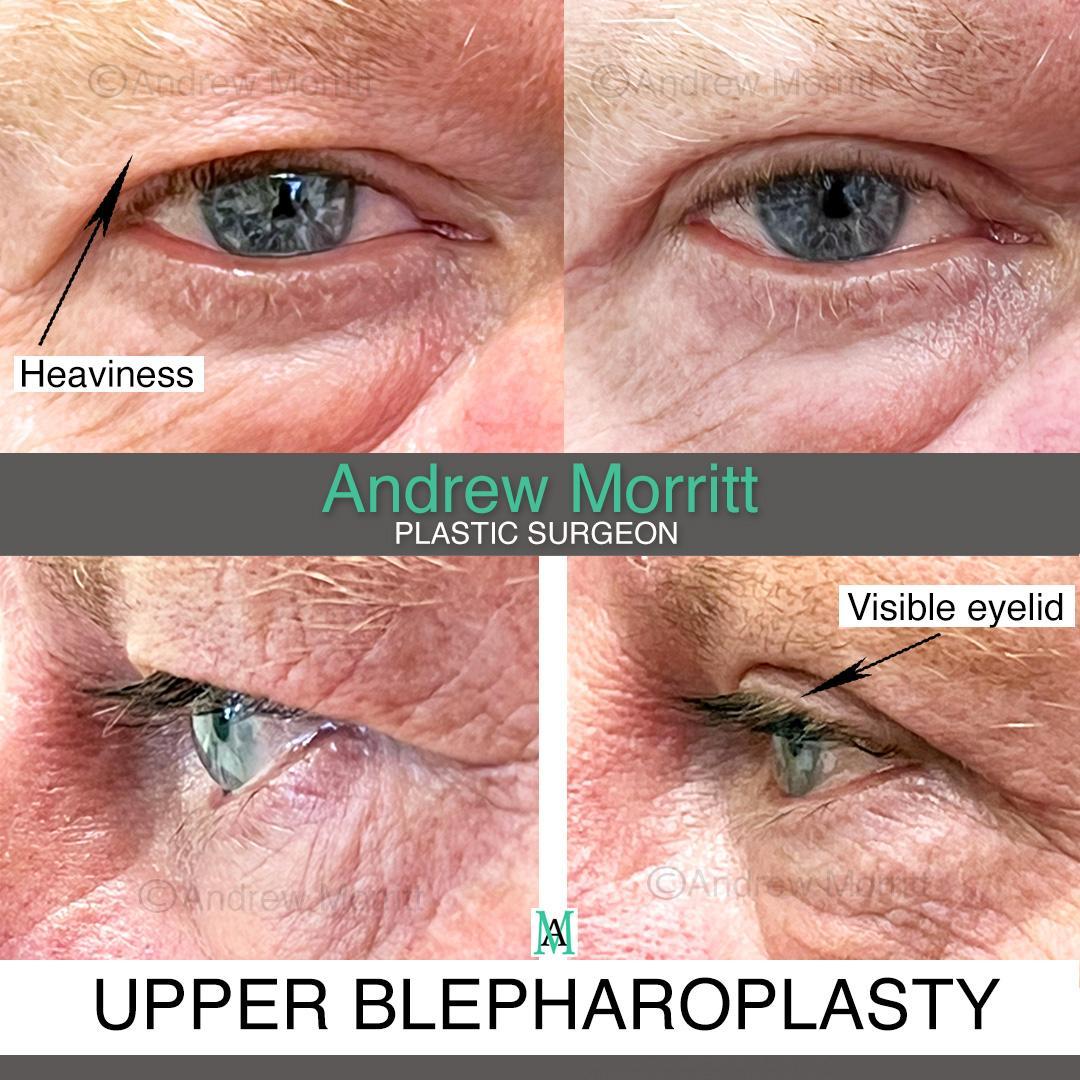
Case 11. Photos showing appearances before and 8 weeks after upper blepharoplasty eyelid surgery. This man in his 50’s was unhappy with the heaviness which made him look tired and wanted a refreshed look. Thanks to my patient for giving permission to show these images.
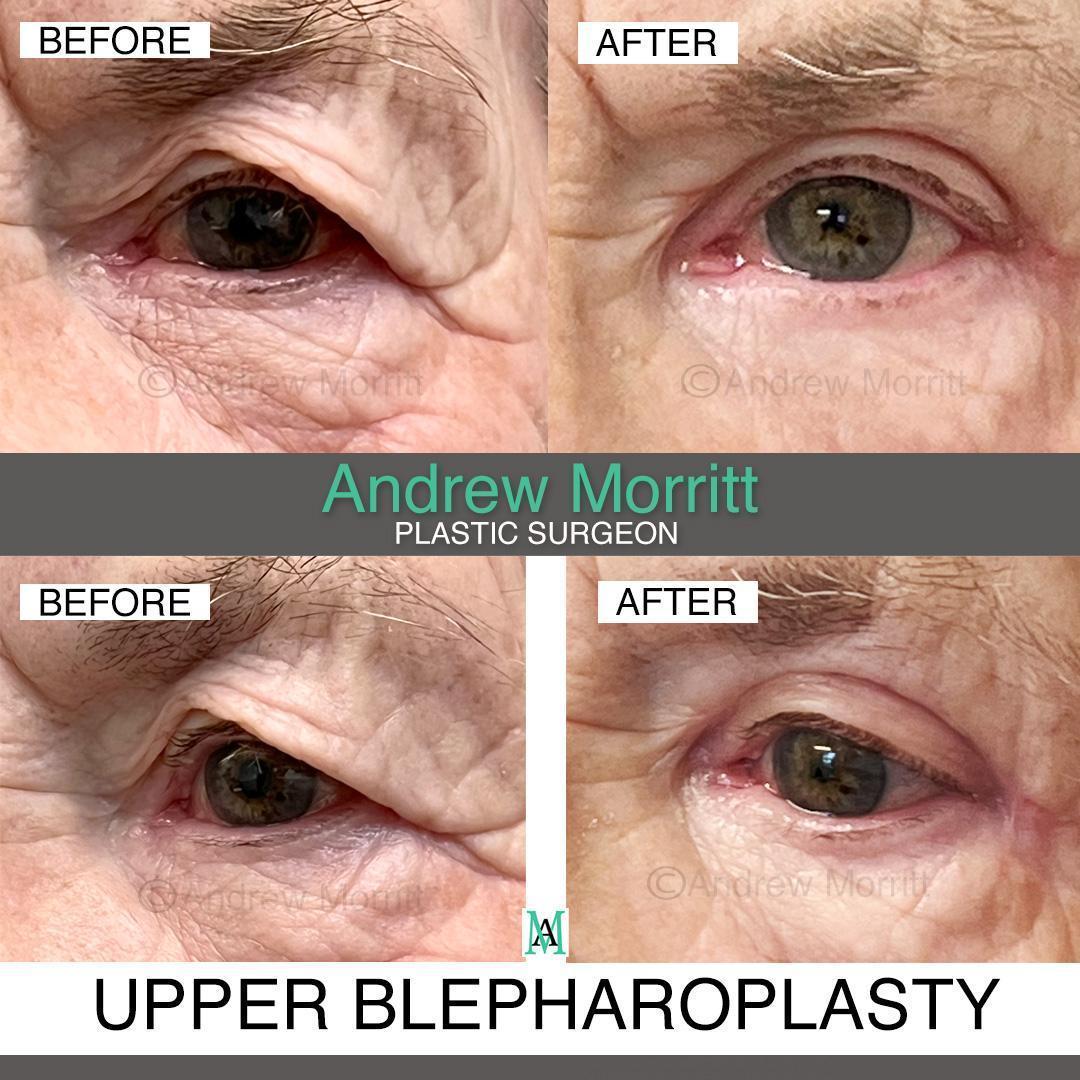
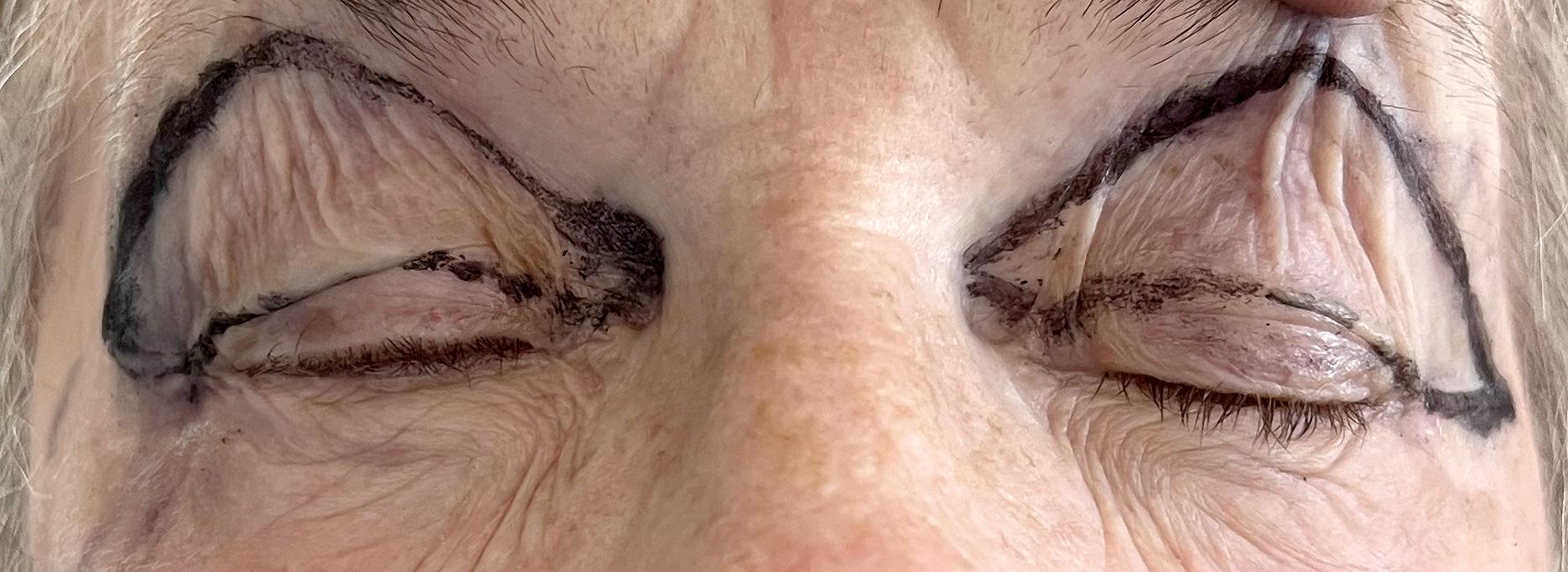
Case 12. Photos showing appearances before and 6 weeks after upper blepharoplasty eyelid surgery. This lady in her 80’s was unhappy with the skin heaviness which was obstructing her vision. Over 2 cm of skin (the surgical markings are shown in the second picture) have been removed from the upper eyelid helping to improve her vision and give better definition to the eyelid crease. Thanks to my patient for giving permission to show these images.
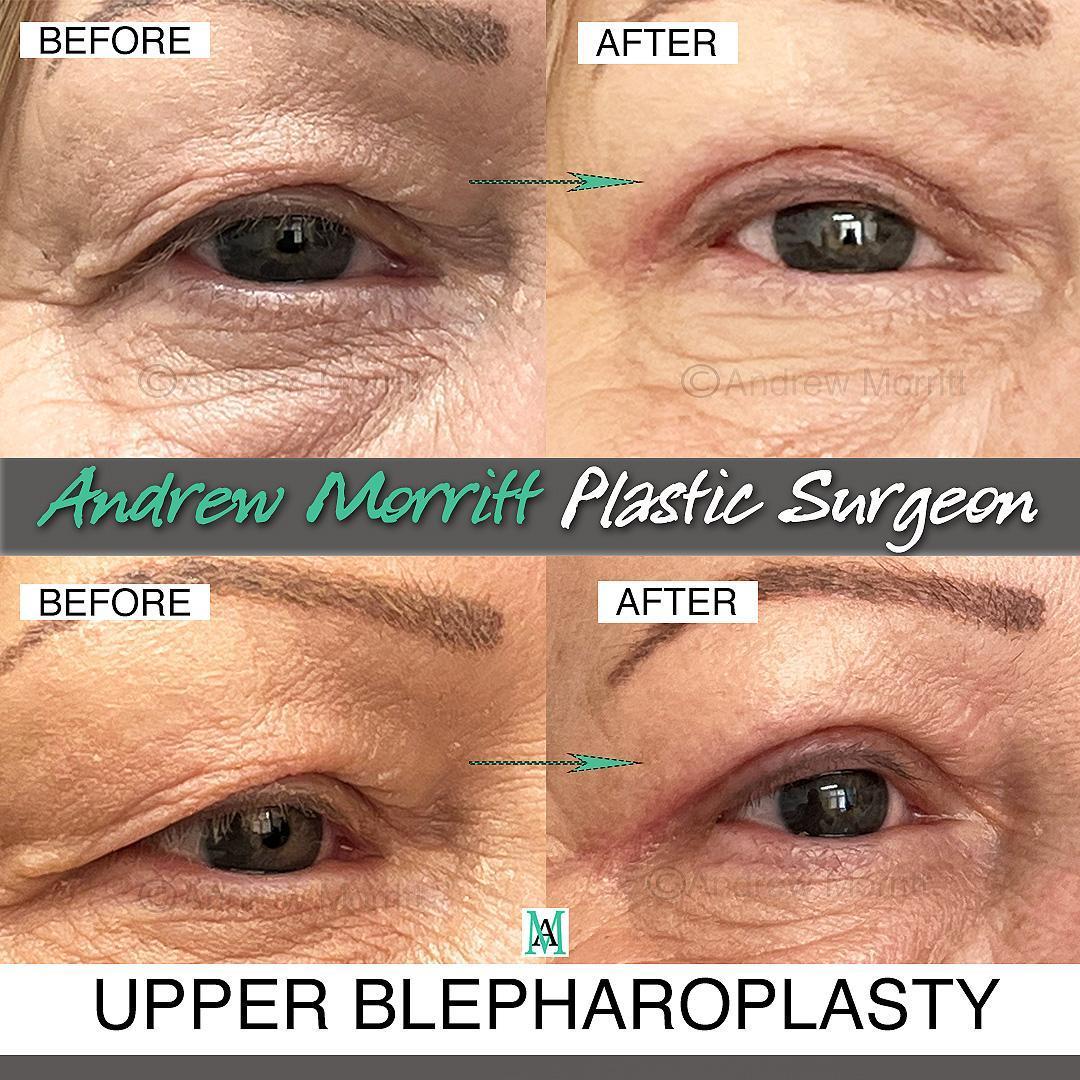
Case 13. Photos showing appearances before and 6 weeks after upper eyelid lift surgery. Excess skin has been removed under local anaesthetic reducing eyelid heaviness and giving a more youthful contour to the eyes. Thanks to my patient for giving permission to show these images.
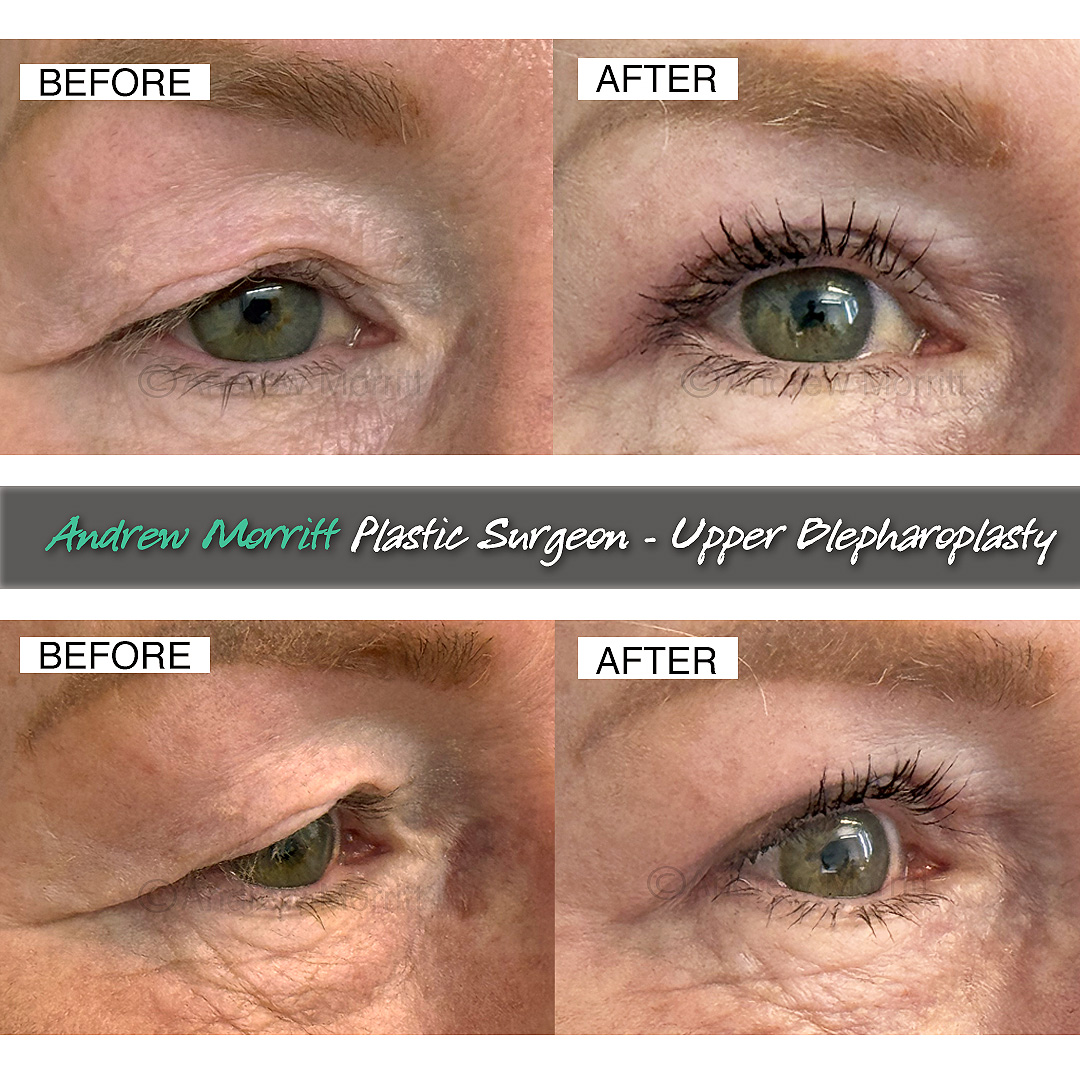
Case 14. Photos before and 6 weeks after upper blepharoplasty surgery. Before surgery the patient’s eyelid skin hung over the eyelashes making it difficult to apply makeup and also obstructing her vision. The excess skin has been removed with an upper blepharoplasty procedure performed with the patient awake (local anaesthetic). Thanks to my patient for giving permission to show these images.
FAQ’s on upper eyelid cosmetic surgery (upper blepharoplasty)
Does upper blepharoplasty hurt?
- there is some initial stinging when the local anaesthetic is injected and then patients should not experience any pain during surgery. After surgery once the local anaesthetic wears off there will be some soreness but this is usually well controlled with paracetamol and only lasts a few days
Will I feel anything during surgery?
- Most patients have upper blepharoplasty under local anaesthetic and are therefore awake during surgery. Patients will therefore feel surgery (but will not feel pain).
How long does upper blepharoplasty take?
- It generally takes approximately 1hr for surgery. This includes time for allowing the local anaesthetic to get to maximum action after it has been injected (approximately 7 minutes after it has been injected), and for applying dressings etc. The surgical time is around 45mins on average which incorporates time for double checking surgical markings, eyelid symmetry and that bleeding has been controlled.
Will too much skin be taken away?
- This is a rare risk of eyelid surgery. Throughout my training I was taught ‘measure twice, cut once’ and follow this principle. The eyelids are marked before surgery and all markings for skin removal are checked at least twice before surgery begins. I explain to my patients that I prefer to be cautious about how much skin is removed to try and minimise the risk of this situation arising. It is quite normal after surgery for the eyelids not to close fully as there is swelling but this usually resolves within a few weeks.
When can I wear eye makeup after upper blepharoplasty?
- I would generally advise waiting a minimum of three weeks before applying eyeshadow and eyeliner to the upper eyelids after surgery. Mascara can be worn from two weeks after surgery.
When can I resume exercise after eyelid surgery?
- Patients are advised to avoid strenuous exercise for approximately 3 weeks after surgery (this means lifting and intense exercise). This is to reduce the risk of post operative bleeding.
Can the eyelid skin return?
- Yes, it is normal for skin to loosen as patients get older so there may come a point at some time after upper blepharoplasty surgery where patients become conscious again of excess skin in the upper eyelid. Whilst no current treatment can prevent natural ageing, it is generally straightforward to repeat the upper blepharoplasty surgery.
Do you remove fat for all upper blepharoplasty procedures?
- In the old days it was completely normal for Plastic surgeons to routinely remove some fat during an upper blepharoplasty procedure. It has become clear that the removal of fat can ultimately make patients look older so I personally avoid removing fat unless patients have particularly large deposits around the eyelid.
Eyelid surgery (blepharoplasty) – risks
Bruising – bruising following the surgery is normal and generally resolves within a few weeks of the surgery. Sometimes patient’s will get ‘black eyes’ which can last up to three weeks after surgery. Generally all bruising has completely resolved within 6 weeks of surgery.
Bleeding – Bleeding following the surgery is uncommon but can cause excessive bruising or swelling. Bleeding requiring a return to theatre for the bleeding to be stopped is very rare. Patients with high blood pressure are at higher risk of bleeding following surgery.
Infection – this is very rare following eyelid surgery. Mr Morritt generally gives all of his patient’s antibiotic ointment to apply to the wound following surgery while the stitches are in in order to reduce the chance of wound infection.
Wound opening – this is uncommon and if it happens generally will only affect a small area of the wound. The opening usually forms a scab that ultimately heals after a few weeks and does not usually affect the final cosmetic result.
Dry eyes – this is relatively common in the first few weeks after surgery and is caused by swelling of the eyelids. As the swelling improves the eyes become less dry. Permanently dry eyes are rare and may require long term artificial tears.
Watery eyes – watering of the eyes is relatively common following the surgery. It is usually caused by swelling and generally resolves very quickly. It can rarely be permanent.
Skin colour changes – very rare and slightly more frequent in the lower eyelid. Generally resolves with time but may be permanent.
Scars – scarring following blepharoplasty is generally very inconspicuous as the incisions are planned to be well hidden and in some patients will be very difficult to see. Rarely poor scars can happen (thickened scaring). Scars take time to become pale and in some cases this may take up to 1 year.
Asymmetry – differences between the eyelids in terms of shape and/or position. Slight differences are common and are in fact normal for many patients before surgery. Significant differences are very unusual and can generally be corrected with minor revision surgery. Eyelids can also heal at direct rates.
Pain – chronic pain/discomfort are very rare following blepharoplasty. Sometimes people have a sensation of ‘pulling’ after surgery but this usually improves with time.
Overcorrection – due to too much skin being removed from the eyelid or excessive scarring and results in it not being possible to close the eye. Can be corrected with a skin graft procedure.
Undercorrection – sometimes not enough skin is removed. This can be remedied by removing more skin.
Double vision – a very rare complication of lower eyelid surgery. Usually temporary but can be permanent.
Loss of vision (blindness) – this a an extremely rare complication reported to affect approximately 1:50,000 patients
Ectropion – this is an uncommon complication of lower blepharoplasty (eye bag removal). The lower eyelid is pulled down exposing the inner pink part. It generally resolves once the swelling has settled but can otherwise be corrected surgically.
Chemosis – swelling of the conjunctiva (pink fleshy tissue around eyeball) – usually temporary
Unhappiness with the cosmetic result – Many patients requesting this surgery often demonstrate the desired effect by lifting their eyebrow. Upper blepharoplasty does not improve eyebrow descent or heaviness – this requires a different procedure called a brow lift (or sometimes can be improved with botox). Upper blepharoplasty does it remove wrinkles from the eyebrow area.
Recurrence of excess skin – with time and natural ageing some patients may develop more excess skin on the upper eyelids. If this happens the surgery can potentially be repeated.
Eye injury – exceptionally rare potential complication from surgery.
Sensation of eyelid tightness – some patients experience a sensation of tightness in their eyelids which usually resolves with time but in rare instances may be permanent.
Changes in vision e.g. blurred vision – it is common to notice differences in vision after upper blepharoplasty surgery. This can be due to swelling or dryness of the eyes after surgery or may even be due to the chloramphenicol ointment that is used after surgery. The vision generally improves as the swelling improves but can take approximately 3 weeks after surgery. Some patients may experience permanent changes in their glasses prescription after surgery.
Blepharoplasty (Eyelid lift) – Video testimonial from one of Mr Morritt’s patients
Blepharoplasty (eyelid lift surgery) reviews – Mr Morritt, Sheffield
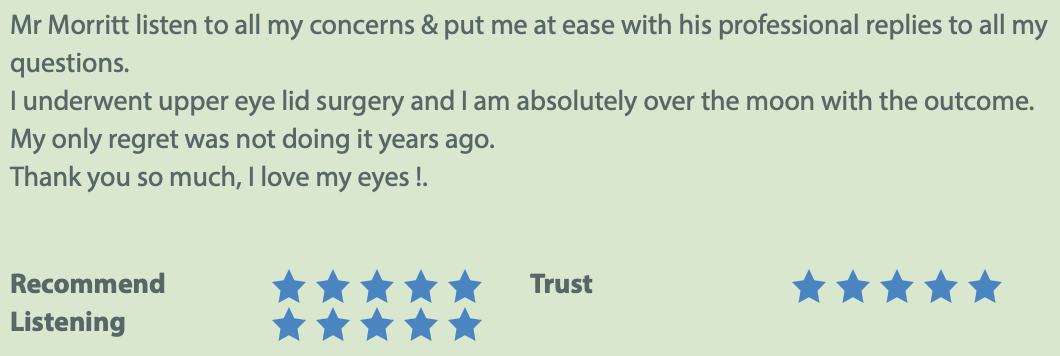
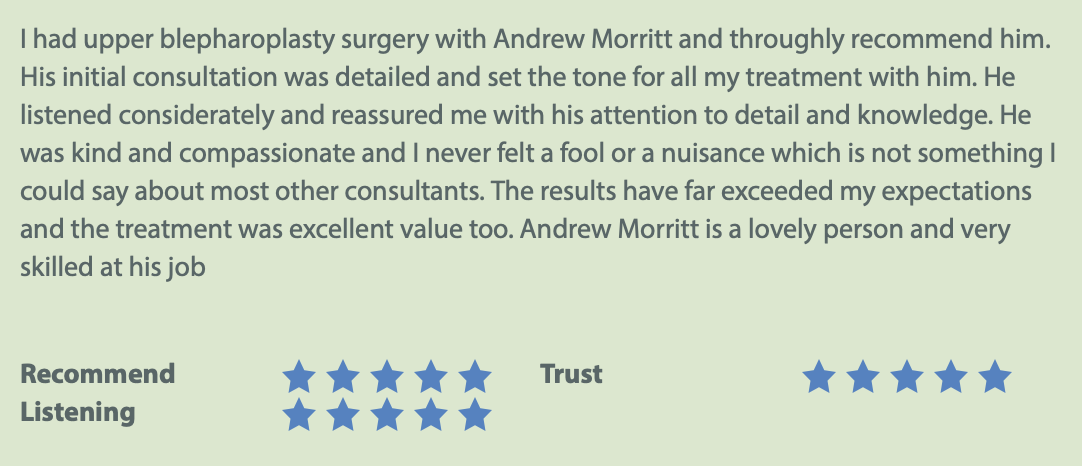
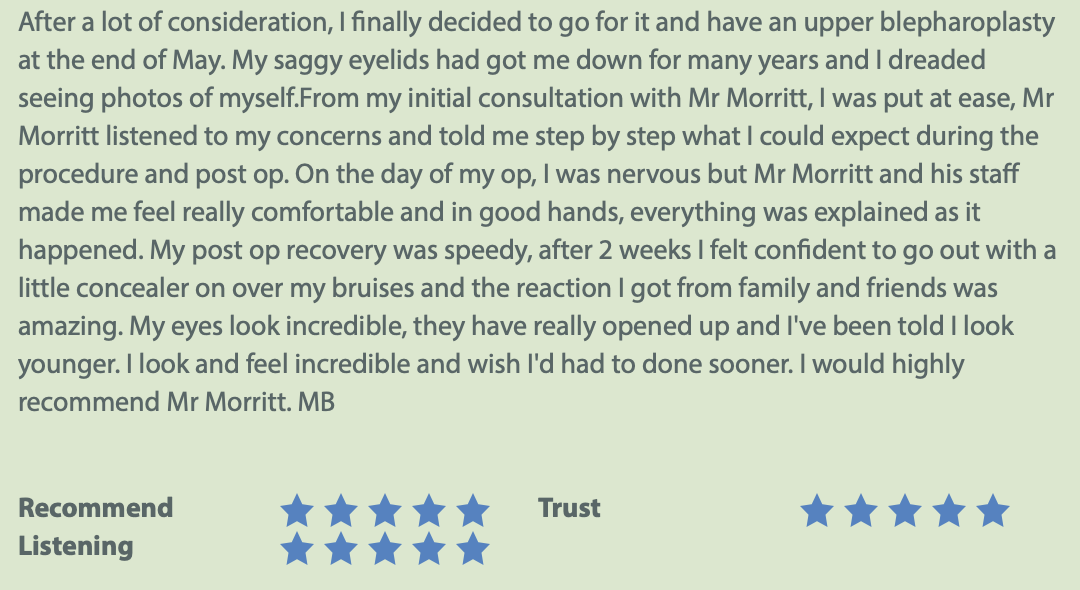
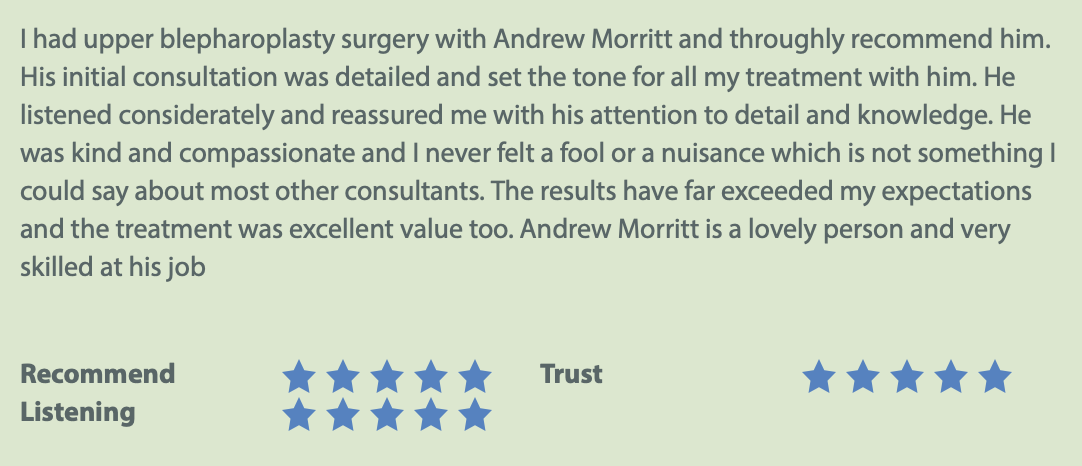
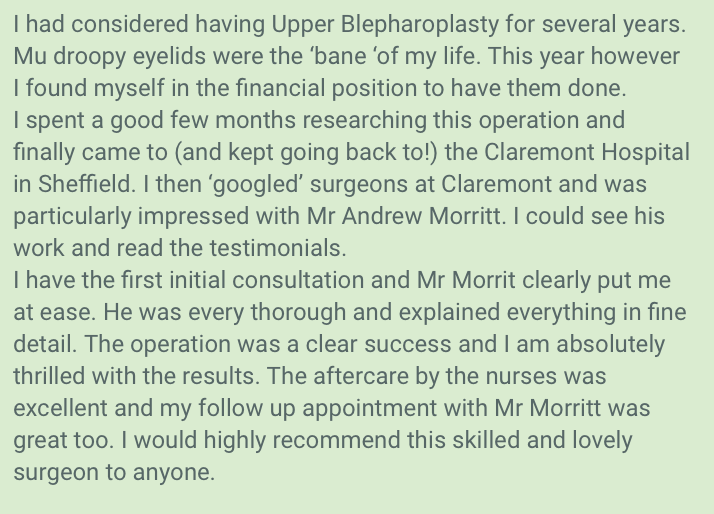
Useful blepharoplasty links
Read more – Sheffield Teaching Hospitals blepharoplasty information leaflet
Read more – BAAPS information on blepharoplasty
Read more – NHS information on blepharoplasty

